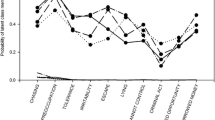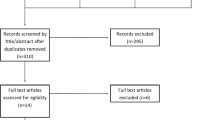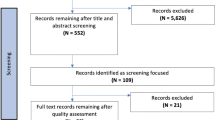Abstract
The case is presented that researchers interested in policy aimed at treating the pathological gambler need to shift focus to improving the utility of prevalence estimates. It is argued that researchers supplement prevalence estimates with practical and well-defined measures of severity and other predictors and correlates of help-seeking. The dimension of severity is emphasized as one means of providing estimates that are relevant to policy makers when placed in the context of additional measures that improve their meaning and utility. Estimates may then be partitioned along these dimensions to ascertain the proportion of gamblers most likely to need or seek treatment for gambling-related disorders. The recommendations provided are subject to a number of possible objections and are presented in the interest of stimulating further discussion such as the distinction between symptom assessment and the measurement of severity.
Similar content being viewed by others
References
Abbott, M. W., Williams M. M., & Volberg, R. A. (1999). Seven years on: A follow-up study of frequent and problem gamblers living in the community. Report No. 2 of the New Zealand Gaming Survey. Wellington, New Zealand: Department of Internal Affairs.
Blaszczynski, A., Ladouceur, R., & Shaffer, H. J. (2004). A science-based framework for responsible gambling. Journal of Gambling Studies, 20, 301–317.
Clarke, D. M., & McKenzie, D. P. (1994). A caution on the use of cut-points applied to screening instruments or diagnostic criteria. Journal of Psychiatric Research, 28, 185–188.
Cunningham-Williams, R. M., & Cottler, L. B. (2001). The epidemiology of pathological gambling. Seminars in Clinical Neuropsychiatry, 6, 155–166.
Cunningham-Williams, R. M., Cottler L. B., & Womack, S. B. (2004). Epidemiology. In J. E. Grant & M. N. Potenza (Eds.), Pathological gambling: A clinical guide to treatment (pp. 25–36). Washington, DC: American Psychiatric Publishing.
Derevensky, J. L., Gupta, R., & Dickson, L. (2004). Prevention and treatment of adolescent problem and pathological gambling. In J. E. Grant & M. N. Potenza (Eds.), Pathological gambling: A clinical guide to treatment (pp. 159–168). Washington, DC: American Psychiatric Publishing.
Derevensky, J. L., Gupta, R., & Winters, K. (2003). Prevalence rates of youth gambling problems: Are the current rates inflated? Journal of Gambling Studies, 19, 405–425.
Eisen, S. A., Lin, N., Lyons, M. J., et al. (1998). Familial influences on gambling behavior: An analysis of 3359 twin pairs. Addiction, 93, 1375–1384.
Evans, R. I. (2003). Some theoretical models and constructs generic to substance abuse prevention programs for adolescents: Possible relevance and limitations for problem gambling. Journal of Gambling Studies, 19, 287–302.
Finlayson, T. L., Moyer, C. A., & Sonnad S. S. (2004). Assessing symptoms, disease severity, and quality of life in the clinical context: A theoretical framework. The American Journal of Managed Care, 10, 336–344.
Gambino, B. (2004). To test or not to test that is the question. Weekly Addiction Gambling Education Report, 9, 1–16 (January).
Gambino, B. (2005). Interpreting prevalence estimates of pathological gambling: Implications for policy. Journal of Gambling Issues, 14, 1–19.
Gordis, L. (1996). Epidemiology. Philadelphia: W.B. Saunders.
Hadorn, D. C. (2000). Setting priorities for waiting lists: Defining our terms. Canadian Medical Association Journal, 163, 857–860.
Hodgins, D. C., & el-Guebaly, N. (2000). Natural and treatment-assisted recovery from gambling problems: A comparison of resolved and active gamblers. Addiction, 95, 777–789.
Ibanez, A., Blanco, C., Donahue, E., Lesieur, H. R., Perez de Castro, I., Fernandez-Piqueras, J., & Saiz-Ruiz, J. (2001). Psychiatric comorbidity in pathological gamblers seeking treatment. American Journal of Psychiatry, 158, 1733–1735.
Jenkins, R. (2003). Making psychiatric epidemiology useful: The contribution of epidemiology to government policy. International Review of Psychiatry, 15, 188–200.
Kessler, R. C. (2002). Epidemiologic perspectives for the development of future diagnostic systems. Psychopathology, 35, 158–161.
Kessler, R. C., et al. (1996). The twelve-month prevalence and correlates of serious mental illness (SMI). In R. W. Manderscheid & M. A. Sonnenschein (Eds.), Mental health, United States (pp. 96–3098). DHHS Pub. no (SMA) 96-3098. Washington, DC: U.S. Government Printing Office.
Kessler, R. C., Merikangas, K. R., Berglund, P., Eaton, W. W., Koretz, D. S., & Walters, M. S. (2003). Mild disorders should not be eliminated from the DSM-V. Archives of General Psychiatry, 60, 1117–1122.
Koeter, M. J. W., de Fuentes-Merillas, L., Schippers, G. M., & van den Brink, W. (2003). Severity of gambling addiction: Development of a new assessment instrument. World Psychiatry, 2(Supplement 1).
Korn, D. A., & Shaffer, H. J. (2004). Practice guidelines for treating gambling-related problems. Boston: Massachusetts Council on Compulsive Gambling.
Ladd, G., & Petry, N. M. (2003). A comparison of pathological gamblers with and without substance abuse histories. Experimental Clinical Psychopharmacology, 11, 202–209.
Lesieur, H. R., & Blume, S. B. (1987). South Oaks Gambling Screen (SOGS): A new instrument for the identification of pathological gamblers. American Journal of Psychiatry, 144, 1184–1188.
Lopez, A. D. (2003). Evidence and information for health policy: A decade of change. Medical Journal of Australia, 179, 396–397.
Mechanic, D. (2002). Removing barriers to care among persons with psychiatric symptoms. Health Affairs, 21, 137–147.
Mechanic, D. (2003). Is the prevalence of mental disorders a good measure of the need for services? Health Affairs, 22, 8–20.
Narrow, W. E., Rae, D. S., Robins, L. S., & Regier, D. A. (2002). Revised prevalence estimates of mental disorders in the United States: Using a clinical significance criterion to reconcile 2 survey estimates. Archives of General Psychiatry, 59, 115–123.
Nathan, P. E. (2003). The role of natural recovery in alcoholism and pathological gambling. Journal of Gambling Studies, 19, 279–286.
Newman, S. C., & Thompson, A. H. (2003). A population-based study of the association between pathological gambling and attempted suicide. Suicide and Life Threatening Behavior, 33, 80–87.
Oakley-Browne, M. A., Adams, P., & Mobberley, P. M. (2002). Interventions for pathological gambling (Cochrane Review), The Cochrane Library (p. 23). Oxford: Update Software.
O’Conner, R. (2004). Measuring quality of life in health. London: Elsevier.
Orford, J., Sproston, K., & Erens, B. (2003). SOGS and DSM-IV in the British gambling prevalence survey: Reliability and factor structure. International Gambling Studies, 3, 53–65.
PA-05-037 (December, 30, 2004). Functional assessment of people with mental disorders. Available at http://grants,nih.gov/grants/guide/pa-files/PA-05-037.html
Petry N. M., & Armentano, C. (1999). Prevalence, assessment, and treatment of pathological gambling: A review. Psychiatric Services, 50, 1021–1027.
Petry, N. M., & Kiluk, B. D. (2002). Suicidal ideation and suicide attempts in treatment-seeking pathological gamblers. Journal of Nervous & Mental Disease, 190, 462–469.
Pincus, H. A., Zarin, D. A., & First, M. (1998). “Clinical significance” and DSM IV. Archives of General Psychiatry, 55, 1145.
Potenza, M. N., Steinberg, M. A., McLaughlin, S. D., Rounsaville, B. J., & O’Malley, S. S. (2000). Illegal behaviors in problem gambling: Analysis of data from a gambling helpline. Journal of American Academy of Psychiatry and Law, 28, 389–403.
Poulin, C. (2002). An assessment of the validity and reliability of the SOGS-RA. Journal of Gambling Studies, 18, 67–93.
Productivity Commission (1999). Australia’s gambling industries. Report No. 10, AusInfo, Canberra, Australia.
Rockloff, M. J., & Schofield, G. (2004). Factor analysis of barriers to treatment for problem gambling. Journal of Gambling Studies, 20, 121–126.
Rosenbaum, J. F., & Pollack, R. A. (2002). DSM-V – Plans and perspectives. Program and abstracts of the American Psychiatric Association, 155th Annual Meeting; May 18–23, Philadelphia: PA.
Schmitz, N., Kruse, J., & Tress, W. (2000). Application of stratum-specific likelihood ratios in mental health screening. Social Psychiatry & Psychiatric Epidemiology, 35, 375–379.
Shaffer, H. J., & Hall, M. N. (2002). The natural history of gambling and drinking Problems among casino employees. The Journal of Social Psychology, 142, 405–424.
Shaffer, H. J., & Kidman, R. (2004). Gambling and the public health. In J. E. Grant & M. N. Potenza (Eds.), Pathological gambling: A clinical guide to treatment (pp. 3–23). Washington, DC: American Psychiatric Publishing.
Shaffer, H. J. & Korn, D. A. (2002). Gambling and related mental disorders: A public health analysis. Annual Review of Public Health, 23, 171–212.
Shaffer, H. J., Hall, M. N., & Vanderbilt, J. (1997). Estimating the prevalence of disordered gambling in the United States and Canada: A meta-analysis. Boston: Division on Addictions, Harvard Medical School.
Shaffer, H. J., LaBrie, R. A., LaPlante, D. A., Nelson, S. E., & Stanton, M. V. (2004). The road less traveled: Moving from distribution to determinants in the study of gambling epidemiology. Canadian Journal of Psychiatry, 49, 504–516.
Shah, K. R., Potenza, M. N., & Eisen, S. A. (2004). Biological basis for pathological gambling. In J. E. Grant & M. N. Potenza (Eds.), Pathological gambling: A clinical guide to treatment (pp. 127–142). Washington, DC: American Psychiatric Publishing.
Slutske, W. S., Eisen, S., True, W. R., Lyons, M. J., Goldberg, J., & Tsuang, M. (2000). Common genetic vulnerability for pathological gambling and alcohol dependence in men. Archives of General Psychiatry, 57, 666–673.
Slutske, W. S., Jackson, K. M., & Sher, K. J. (2003). The natural history of problem gambling from age 18 to 29. Journal of Abnormal Psychology, 112, 263–274.
Spitzer, R. L. (1998). Diagnosis and need for treatment are not the same. Archives of General Psychiatry, 55, 120.
Stinchfield, R., & Winters, K. C. (2001). Outcome of Minnesota’s gambling treatment programs. Journal of Gambling Studies, 17, 191–215.
Strong, D. R., Breen, R. B., Lesieur, H. R., & Lejuez, C. W. (2003). Using the Rasch model to evaluate the South Oaks Gambling Screen for use with nonpathological gamblers. Addictive Behavior, 28, 1465–1472.
Tavares, H., Zilberman, M. L., Beites, F. J., & Gentil, V. (2001). Brief communications. Gender differences in gambling progression. Journal of Gambling Studies, 17, 151–159.
Toce-Gerstein, M., Gerstein, D. R., & Volberg, R. A. (2003). A hierarchy of gambling disorders in the community. Addiction, 98, 1661–1672.
Toneatto, T. (2005). A perspective on problem gambling treatment: Issues and challenges. Journal of Gambling Studies, 21, 75–80.
Tremayne, K., Masterman-Smith, H., & McMillen, J. (2001). Survey of the nature and extent of gambling and problem gambling in the ACT. Australian Institute for Gambling Research, University of Western Sydney.
Ustun, T. B., & Rehm, J. (1998). Limitations of diagnostic paradigm: It doesn’t Explain need. Archives of General Psychiatry, 55, 1145–1146.
Vogel, D. L., & Wester, S. R. (2003). To seek help or not to seek help: The risks of self-disclosure. Journal of Counseling Psychology, 50, 351–361.
Volberg, R. A. (2004). Fifteen years of problem gambling prevalence research: What do we know? Where do we go? The Electronic Journal of Gambling Issues, 10, 1–19.
Wakefield, J. C., & Spitzer, R. L. (2002). Lowered estimates—but of what? Archives of General Psychiatry, 59, 129–130.
Walters, G. D. (2001). Behavior genetic research on gambling and problem gambling: A preliminary meta-analysis of available data. Journal of Gambling Studies, 17, 255–271.
Welte, J. W., Barnes, G. M., Wieczorek, W. F., Tidwell, M., & Parker, J. (2001). Alcohol and gambling among U.S. adults: Prevalence, demographic patterns and comorbidity. Journal of Studies on Alcohol, 62, 706–712.
Welte, J. W., Barnes, G. M., Wieczorek, W. F., Tidwell, M., & Parker J. (2002). Gambling participation in the U.S. Results from a national survey. Journal of Gambling Studies, 18, 313–337.
Welte, J. W., Barnes, G. M., Wieczorek, W. F., Tidwell, M., & Parker, J. (2004). Risk Factors for pathological gambling. Addictive Behaviors, 29, 323–335.
WHO (2004). Prevalence, severity, and unmet need for treatment of mental disorders in the World Health Organization World Mental Health Surveys. Journal of the Medical Association, 291, 2581–2590.
Winters, K. C., Specker, S., & Stinchfield, R. (1997). Brief manual for use of the diagnostic interview for gambling severity. Minneapolis, MN: University of Minnesota Medical School.
Winters, K. C., Stinchfield, R. D., Botzet, A., & Anderson, N. (2002). A prospective study of youth gambling behaviors. Psychology of Addictive Behaviors, 16, 3–9.
Yaffee, R. C. (1990). Severity of compulsive gambling and co-addiction in Maryland. Prepared for the Maryland Task Force on Gambling Addiction. Available at http://www.nyu.edu/its/socsci/Docs/task_force_6.html.
Author information
Authors and Affiliations
Corresponding author
Rights and permissions
About this article
Cite this article
Gambino, B. A Comment on the Utility of Prevalence Estimates of Pathological Gambling. J Gambl Stud 22, 321–328 (2006). https://doi.org/10.1007/s10899-006-9019-3
Published:
Issue Date:
DOI: https://doi.org/10.1007/s10899-006-9019-3




